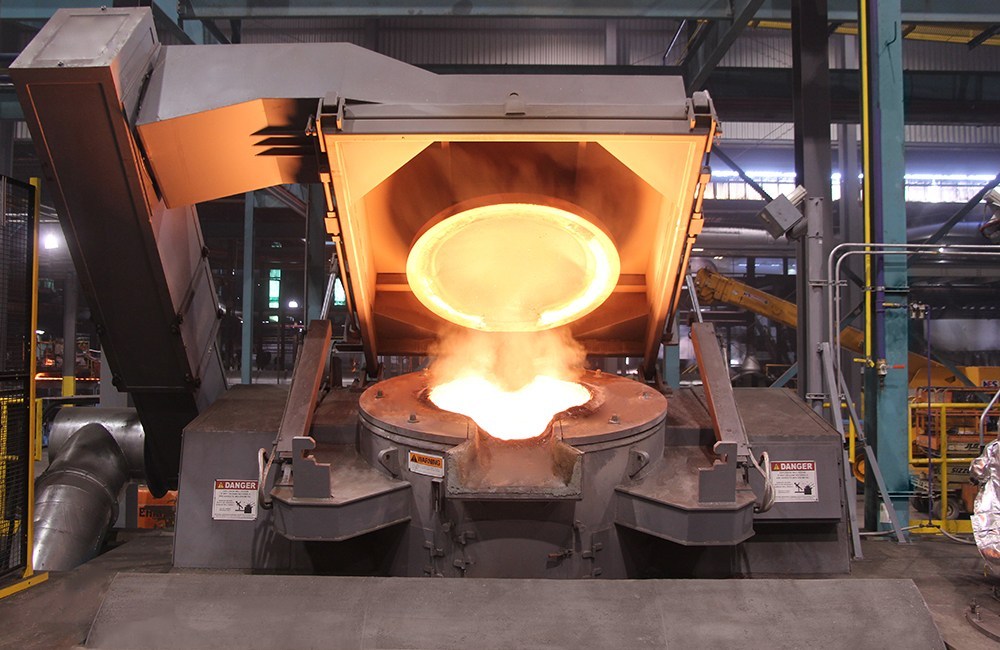Induction furnace in steel casting advantages and disadvantages lining selection and smelting process
1. Compared with other steelmaking methods, induction furnace steelmaking has the following advantages
1.1 Carbon electrodes are not used, and carbon will not be added during the smelting process, so steels and alloys with very low carbon content can be smelted.
1.2 There is no arc, which can avoid the decomposition of gas in the high temperature zone of the arc, so steel with low gas content can be smelted.
1.3 The adjustment of power and temperature is simple and convenient, and its range is wide, which can accurately control the temperature required by the metal.
1.4 The electric stirring action of the molten steel in the crucible accelerates the metallurgical reaction between the molten steel and the slag, and can promote the removal of non-metallic inclusions and gases, and is also conducive to the uniformity of the temperature and chemical composition of the molten steel.
1.5 The recovery rate of alloy elements is high. Alloy elements that are easily oxidized can be added when the molten steel is well deoxidized. The unit surface area of the induction furnace molten pool is small, so the burnout of alloy elements is small and the recovery rate is high.
1.6 Melting can be carried out under vacuum or in an atmosphere that is favorable for melting.
2. Induction furnace steelmaking has the following disadvantages
2.1 The slag cannot be heated by induction, but can only be heated by molten steel. Therefore, the slag temperature is low, which is not conducive to the reaction between the slag and steel interface.
2.2 The crucible wall is thin, coupled with the continuous stirring and scouring of the metal flow, the scouring and erosion of the slag, and the large temperature difference between the inside and outside of the crucible wall, the crucible life is short, generally only a few dozen times.
3. Furnace lining selection and smelting process
3.1 Select the required lining material according to the type of steel to be smelted
Some steel types are only suitable for smelting in alkaline furnaces. When smelting high-manganese steels and alloys in acidic furnaces, (MnO) will combine with SiO2 in the lining to form low-melting silicates, thereby quickly damaging the lining. When smelting steels and alloys with high aluminum and titanium content, the aluminum and titanium contained will cause a large amount of silicon dioxide in the lining to be reduced, which not only damages the lining, but also makes it difficult to control the silicon in the steel. In addition, the high chromium-nickel steel produced in the acid furnace contains more silica inclusions than the alkaline furnace; therefore, it is best to melt this steel in the alkaline furnace.
3.2 Charge
Induction furnace smelting is basically a melting process. Oxidation smelting is rarely used. The slag temperature is low, the ability to remove sulfur and phosphorus is poor, and the smelting time is very short. The chemical composition cannot be controlled by furnace analysis. For these reasons, the requirements for the charge are very strict.
The sulfur and phosphorus content in the charge should be as low as possible, at least 0.005% to 0.01% lower than the lower limit of the specification. The weight and chemical composition of all the charges, including various ferroalloys, must be accurately mastered so that the composition of the steel can be controlled by calculation during the smelting process. The charge should be clean, dry and rust-free, especially for gas-sensitive steels and alloys such as nickel-based alloys. The charge and slag must be fully preheated and baked before use.
The block size of the charge should be appropriate to ensure the charging density. Too fine a charge increases the contact area between the charges. When the charge is too large, the bulk density of the entire charge column decreases. Both increase the resistance value of the charge column.
3.3 Charging and Melting
Before charging, the residual steel and slag in the furnace should be removed, and the damage to the furnace lining should be checked. The local damage should be repaired if it turns black due to rapid cooling. The particle size of the repair material should be smaller than the knotting material, and the adhesive used should be slightly more. Large furnaces with severe damage can be hoisted into iron molds for filling and knotting.
Because the induction furnace cools down quickly after steel is tapped, it must be charged quickly. Charge barrels should be used as much as possible. To accelerate melting, the charge should be reasonably distributed according to the temperature distribution in the furnace.
In order to form slag in advance, slag accounting for 1% of the charge weight can be added to the bottom of the furnace before charging. Lime and fluorite are added to alkaline furnaces, and broken glass is added to acid furnaces.
At the beginning of melting, the current is unstable because the inductance and capacitance on the line cannot be matched quickly, so low power can only be supplied in a short time. After the current stabilizes, it should be switched to full load power supply. The capacitance should be adjusted continuously during the melting process to keep the electrical equipment with a high power factor. After the charge is fully melted, the molten steel is heated to a certain degree, and then the input power is reduced according to the smelting requirements.
The appropriate melting time should be controlled. If the melting time is too short, it will cause difficulties in the selection of voltage and capacitance, and if it is too long, it will increase the useless heat loss.
The “bridging” phenomenon will occur if the charge is improperly laid or the charge contains too much rust. Otherwise, the overheating of the bottom molten steel will not only damage the furnace lining, but also cause the molten steel to absorb a large amount of gas.
Due to the electromagnetic stirring, the middle part of the molten steel rises, and the slag often flows to the edge of the crucible and sticks to the furnace wall. Therefore, slag should be continuously added according to the furnace conditions during the melting process.
3.4 Refining and deoxidation
Deoxidation is one of the important tasks of induction furnace smelting. In order to achieve a good deoxidation effect, the first thing to do is to choose a slag with suitable composition. The temperature of the induction furnace slag is relatively low, so a slag with a low melting point and good fluidity should be selected. Usually 70% lime and 30% fluorite are used as alkaline slag materials. Since fluorite is constantly volatilized during the smelting process, it should be replenished at any time, but considering the erosion and penetration of fluorite on the crucible, the amount added should not be too much.
The alloying of the induction furnace is the same as that of the electric arc furnace. Some alloying elements can be added during charging, and some can be added when the deoxidation is good. When the slag is completely reduced, the alloying operation can be carried out. Before the addition of easily oxidizable elements, the reducing slag can be completely or partially removed to increase its recovery rate. Due to the electromagnetic stirring effect, the added ferroalloy generally melts faster and is more evenly distributed.
The temperature before tapping can be measured by an optical pyrometer or an inserted thermocouple. Aluminum can be inserted for final deoxidation before tapping.





